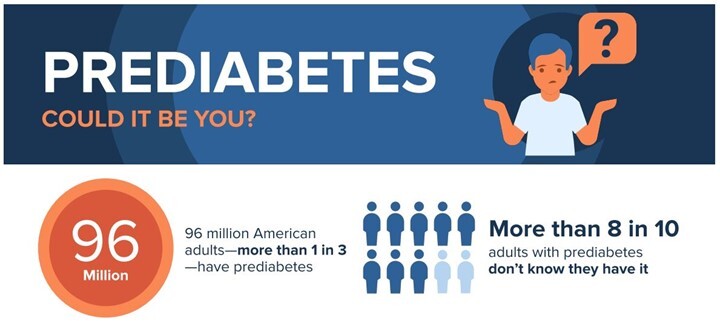|
View this as a webpage
Identifying prediabetes to defeat diabetes
Each November during Diabetes Awareness Month, the diabetes community comes together to call attention to the nation’s diabetes epidemic. For the millions who are at risk for diabetes, it’s a time to become educated, review resources, understand personal risk factors, and learn lifestyle interventions to reduce their risk. And for the millions of people who are living with diabetes, it’s an opportunity to learn about new treatment and technology options, share stories of challenges and successes of life with diabetes, and find resources to manage blood sugars.
Prediabetes is a clear but silent warning sign that type 2 diabetes is a growing health risk. More than 1 in 3 people have prediabetes. A prediabetes diagnosis means blood sugar levels are above normal but are not yet high enough to be classified as type 2 diabetes. The good news is type 2 diabetes often can be prevented or delayed through simple lifestyle changes. Weight loss of just 5-7%, coupled with 150 minutes of physical activity per week, cuts the risk of diabetes by 58% (71% for ages 60+).
Many people, 8 out of 10 in fact, who have prediabetes are not even aware they have it. Prediabetes can be diagnosed through a simple blood test during preventive care visits. Or take a free online risk test. Talk to your doctor if your score is five or higher or to discuss your personal risk for prediabetes.
Learn more on the MDH website:

Minnesota communities collaborate with MDH to improve health, reduce impacts of diabetes and other chronic conditions.
Diabetes, cardiovascular disease, and stroke—along with associated risk factors like high blood pressure and high cholesterol—have enormous impacts on Minnesotans and Minnesota’s communities. Combined, these three conditions are responsible for approximately one in every four deaths in Minnesota annually.
|
A newly released road map and call to action to prevent, treat, and manage diabetes, cardiovascular disease, and stroke through 2035 is Minnesota's Action Plan to Address Cardiovascular Disease, Stroke and Diabetes 2035 (MN 2035 Plan). It was created by more than 90 organizations and communities most impacted by these conditions.
The MN 2035 Plan lays out detailed strategies and example actions that when implemented at the institutional, local, regional, state, and tribal levels will save lives, reduce health disparities, and improve health and well-being.
|
|
 |
A full list of participating organizations, as well as a full copy of the plan and the links to the ongoing Minnesota success stories, can be found at the MN 2035 Plan website at https://www.health.state.mn.us/2035plan. To connect with others interested in working towards the goals of this plan contact health.MN2035Plan@state.mn.us.
Did You Know?
Diabetes, heart disease and stroke occur unequally throughout Minnesota communities. Those most impacted include:
- American Indian, African American, Hispanic and Latine, Somali, Hmong and other Asian communities
- Rural residents
- Low-income individuals and families
- Unemployed
- Uninsured and underinsured individuals
- Members of the LGBTQIA+ community
- People with physical and/or mental disabilities
- New immigrants
The age-adjusted prevalence of diabetes in Minnesota is 7.7% (2018-2020 BRFSS). The prevalence is disproportionately higher in some communities and population groups.
- American Indian (19.3%)
- Black, African, and African American (13.4%)
- Hispanic or Latino populations (11.5%)
MN 2035 Plan partner highlight: Center for African Immigrant Refugees Organization (CAIRO)
CAIRO is a central Minnesota nonprofit that serves the immigrant community, particularly people from Africa and works to increase equity and social justice through programs, services, community organizing and collaborative leadership. One of CAIRO’s priority areas is community health and their leadership recognizes the significant impact diabetes has on their community.
 |
|
Certified Community Health Workers from CAIRO and the Whitney Senior Center in St. Cloud have teamed up to offer the National Diabetes Prevention Program to community members. |
Through this specifically tailored health education, participants thrive in an environment where they feel safe, understood, and respected as they work to incorporate lifestyle changes to reduce their risk for developing type 2 diabetes.
MDH would like to recognize CAIRO’s work and their collaboration on the MN 2035 Plan. Learn more by watching the video: Whitney Senior Center and CAIRO Success Story
|